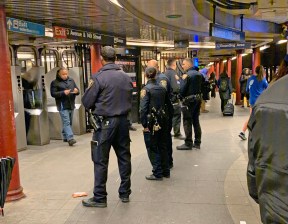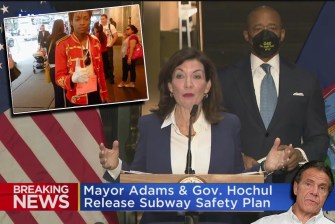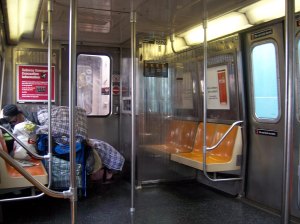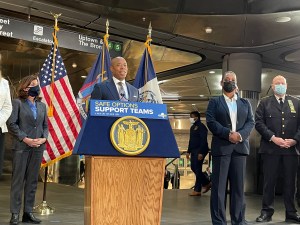Op-Ed: Homeless Will Be ‘Sanitized’ From Subways — But To Where?
Scapegoated again for the system's problems, they will be cast out overnight as the trains shut down. But there are hotel rooms — if the mayor would move.
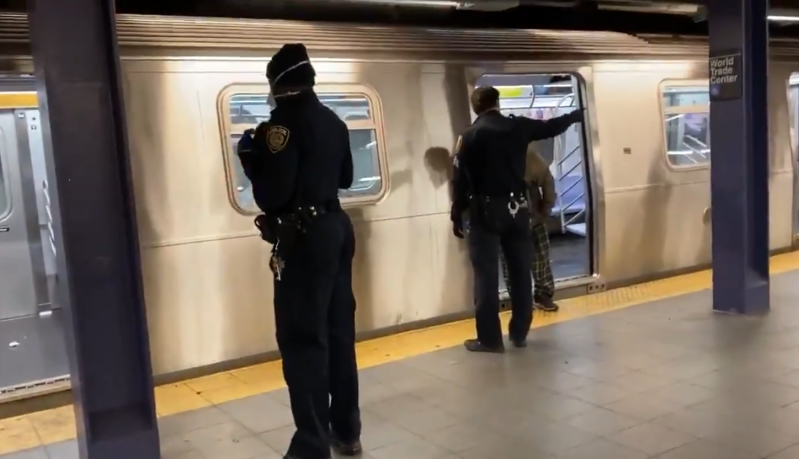
Gov. Cuomo’s announcement on Thursday that the entire subway system will close each morning from 1 to 5 a.m. for coronavirus disinfection means that hundreds of homeless New Yorkers will be ejected from the subway. They literally will be sanitized away in the name of public health and safety — even as our leaders shirk responsibility for addressing the needs that caused the homeless to seek refuge in the subway in the first place.
Yet a simple solution exists: With federal reimbursement funding through FEMA, and services funding from the recently expanded HUD Emergency Solutions Grants, the city could place the homeless in single-occupancy hotel rooms, some 100,000 of which sit vacant across the city. Mayor de Blasio announced on Wednesday that he was moving 6,000 homeless people into such rooms — but only from shelters, not from the subway. The need for rooms is more like 30,000 — or five times what the mayor claims he is providing.
Our leaders, sadly, have scapegoated the homeless for public transit’s problems for years. Last summer, the governor blamed homeless riders for delays that are mostly caused by the MTA’s out-of-date technology. Now, he and the mayor are blaming homeless individuals for spreading a virus that could be spread by almost anyone who enters the subway.
The blame game has resulted only in more police underground, without any substantive improvement in the conditions affecting subway riders (including homeless riders) and transit workers. We do not doubt that the current initiative will comprise more of the same.
As the city deflects and blames, our mayor and governor have provided no reasonable alternatives for homeless New Yorkers sleeping in the subway — only excuses.
It’s perfectly understandable why someone would prefer to sleep on the trains rather than in a shelter. Shelter residents often sleep within three feet of each other, and there are more than 660 positive COVID-19 cases among shelter residents spread across 166 shelter locations.
The mayor has touted “safe havens,” a kind of transitional facility offering more flexibility and privacy than a traditional shelter. But the so-called safe havens do not allow for the social distancing that we are all told will save lives and are likely to “put people at risk,” according to health care professionals.
The mayor’s strategy for outreach to the homeless in the subway — deploying police officers alongside social-service workers — also doesn’t work and only will drive people further away from the “services” he claims to want to provide.
https://twitter.com/nwmalinowski/status/1255845308271075328
The NYPD has targeted, demeaned, and harassed homeless New Yorkers, especially people of color, for decades; they are far less likely to engage with outreach workers if such workers are accompanied by cops.
Contra the mayor, homeless New Yorkers would be more than happy to come off the streets if offered what is needed: stability and housing.
Recently, the #HomelessCantStayHome campaign raised enough money to offer 27 people sleeping on the streets or subway a place in a private hotel room. Every single person offered immediately accepted, and many more have reached out to ask about the availability of more rooms.
So what is the controversy really about?
The MTA clearly is entering a phase of “selective ridership.” As MTA fares have risen, the city and state have scaled up “quality of life”policing in order to signal the subway is not for us — not for homeless people, not for poor people, not for youth, for vendors or for communities of color.
Discrimination shouldn’t be part of the equation in deciding who can use the New York City subway. New York is supposed to be fair and strong — a city where we all pull together. Anyone should be able to ride our public transit system.
If the mayor and governor really want to help homeless New Yorkers sleeping in the subway, they would provide single hotel rooms — not shelters or safe havens — and permanent housing solutions.
We have the rooms. We have the funding. All we lack is the political will.
Marcus Moore (@MooreMMedia) is a long-time member and board member and Jenny Akchin (@jennyaction) is a former staff member of Picture the Homeless. Picture the Homeless is part of the #HomelessCantStayHome campaign to address the needs of homeless New Yorkers during COVID-19.
